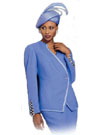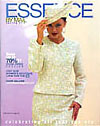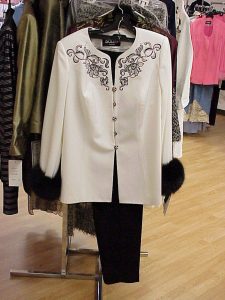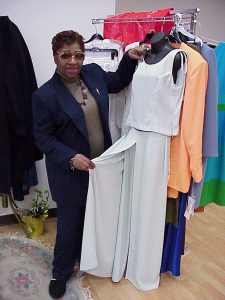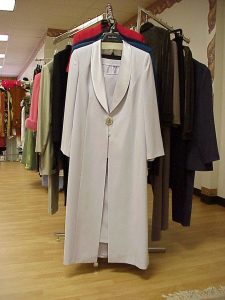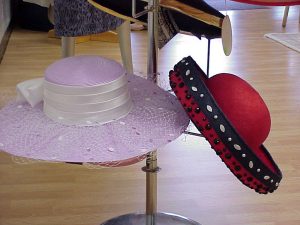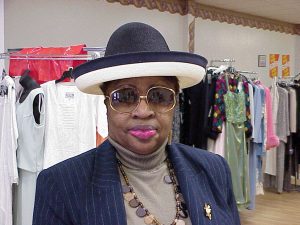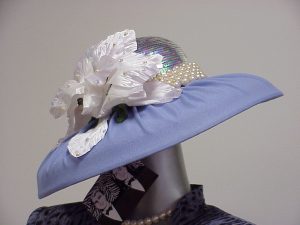- Essence Magazine Fashion 2001
- Essence Magazine Fashion 2001
Dressing up for the glory of God is an important aspect of Sunday service in the African American community. The congregation presents the best of themselves for worship. Accessories, such as fine hats, are also worn complementing women’s Sunday outfits. In Steelton, PA, as many women leave their homes for Sunday service, they confidently step out in style.
During the course of live in domestic service, many African American women had to wear specific uniforms for their duties. In the transition to live out domestic service, African American women began to dress very fashionably for Sunday church services. These fashions consisted of bright colors, double breasted suits, and fine fabrics. “Daily work styles were plain, but women dressed up themselves and their families specially for Sunday worship”(Lynch 82). Dressing up in high fashion was a source of pride for many African American women who had to wear uniforms for work 6 days a week. “After stripping off the stigma of the uniform, the migrant women triumphantly donned hats and dresses and presented themselves at Sunday day church to celebrate their arrival in the promised land of free society”(Clark-Lewis 169). The fashions African American women proudly wear are symbols of independence and freedom.
Swayzyne Savage displays her favorite fashions in her store, Our Boutique. These suits are the style commonly worn to Sunday church services.
Clark-Lewis refers to fashion as one mode of expression among the liberated African American domestic workers. It is a visual representation of their culture. “Aesthetic expression through dress and appearance was a ready means for African Americans to reformulate cultural definitions of male and female gender on the American continent” (Lynch 82). Fashion was important to these women, not only as a display of freedom, but also as a cultural statement. “The church was a place where black women’s moral character, beauty, style was openly recognized and appreciated. At church a black woman could walk down the aisle holding her head up high topped with a fancy and heavily decorated hat and wearing a style that reflected her African American heritage. White observers to the dress of black churchgoers continued to notice differences between their own dress choices and those worn by African Americans” (Lynch 85).
There is a Biblical reference to the importance of a woman covering her head in church for more than just style. Hats, commonly referred to as crowns, have not only set a style for African American women, but they also have continued as a religious tradition.
As stated in the Holy Bible: Corinthians (I.11.5):
“5. But any woman who prays or prophesies with her head unveiled brings shame upon her head, for it is one and the same thing as if she had had her head shaved. 6. For if a woman does not have her head veiled, she may as well have her hair cut off or her head shaved, then she should wear a veil.”
Covering your head has turned into a fashion statement for African American women. Swayzyne Savage reveals that the confident and mature woman adorns the crown. Hats have served a purpose to cover the woman’s head in church, but their styles and fashion have become their own statements.
Swayzyne Savage models the1950s hat that her mother use to wear. The other crowns are for sale in her store, Our Boutique, in Steelton, PA.
Women wore their fashions proudly and were true to their idea of beauty. Lynch states, “While some argue that these performances reinforced compromising female gender constructions for blacks, I would argue that by bringing black beauty out of the closet and on stage to white as well as black audiences, they played a significant role in initiating a movement that will culminate in wider appreciation for black beauty and arts both in Europe and the United States” (86). By displaying black beauty and boldly presenting it to the world, African American culture was embraced rather than regarded as inferior by the dominant society.
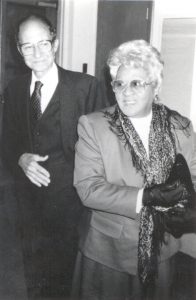
Lois Corbin and her husband dress in their finest for Sunday service.
Within the black church, the expression of freedom through fashion allowed African American women to create a greater sense of community. Joanne Eicher states, “Ethnicity embraces ideas of group cohesion, of insiders versus outsiders, with boundaries that separate outsiders and insiders and symbols that identify members of a group as being distinct from other groups. This Îwe-nessâ includes a common heritage with shared language, similar dress, manners, and lifestyle” (301). Style of dress provided the community with a sense of unity and also pride. The freedom and beauty within African American fashion brought people together and also gave them an identity to call their own. “As freed slaves moved into northern cities public venues were limited, with church services remaining an important arena for expression of African American female identity” (Lynch 84).
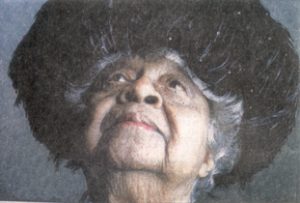
Mother Wright, a Mother of Prison Ministries, is quite fashionable and wears her crown for church services.
As many African American domestic workers began to experience the freedom of Sundays off from work, they began to embrace their individuality and cultural heritage. It was a way for the women to not only display their independence, but to also feel it. “Many women were proud to wear clothing they felt challenged the negative images people had of service workers” (Clark-Lewis 150). In this sense, fashion was not only a physical freedom, but also an emotional outlet for African American women’s expression. As this Sunday culture was established for African American women, time has led Sunday styles through many areas of change, but ultimately they still continue to glorify God.
